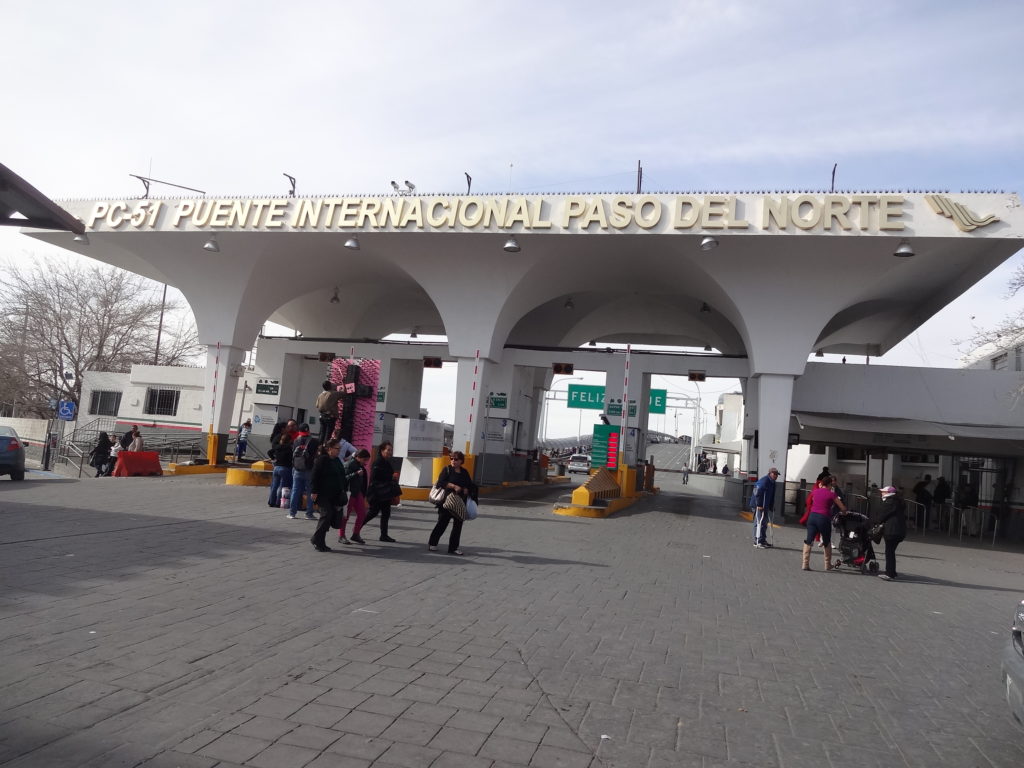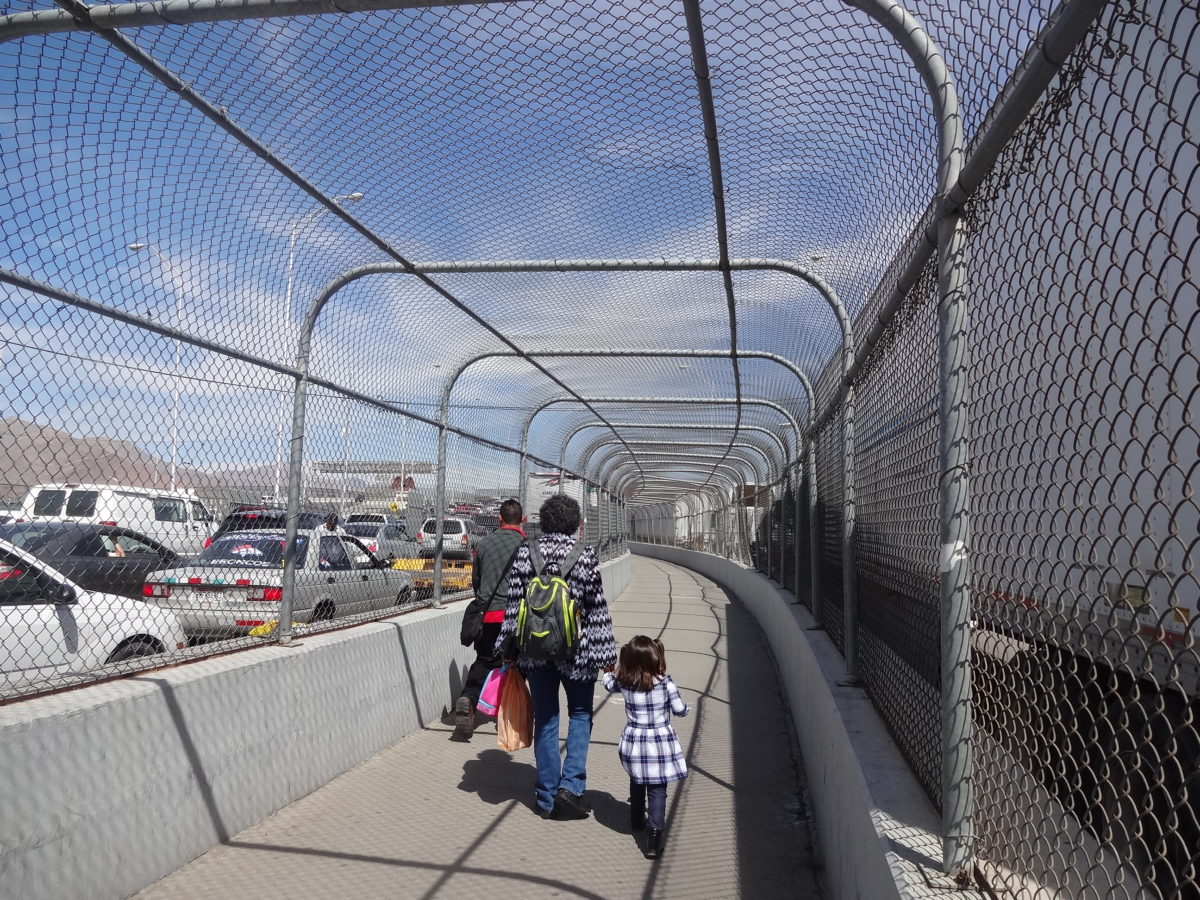This is a work of fiction based on true events.
A year into the pandemic, but before the war, there was a story in the news about how the U.S. Border Patrol agents tricked immigrant mothers, fathers, and their children. The Border Patrol agents put 149 migrants on a plane in south Texas, wrists and ankles shackled, and didn’t tell them the truth about where they were off to. The U.S. Border patrol flew them 600 miles to El Paso, Texas—and then put them onto buses. They drove them to an international bridge that led back to Mexico, in Juárez. The migrants were under the impression that they would be released in the U.S.
As I read the news, I thought about how, just a few years earlier, I had been to this same international bridge between Juárez and El Paso. I also thought about how, in the early morning, American and Mexican soldiers would raise their nations’ flags on two tall posts on that very bridge. These flags were now above these Central American moms, dads, and kids that I was reading about. These families walked in groups of thirty. Behind them, U.S. Border Patrol agents pushed them. Then, as the families arrived at the end of the bridge, U.S. agents passed these families over to the receiving Mexican soldiers.

I kept reading.
Surrounding all of them were chain link fences with coiled barbed wires. A fifty-year-old agent named Dennis stood in the U.S. Border Patrol’s green uniform with the agency’s patch on his right sleeve. On his belt, a strapped handgun was hooked and on his other hip was a two-way radio. Dennis had handcuffs attached to the belt loop near its buckle. He wore black boots, a black ball cap, and a black surgical mask over his nose and mouth.
Dennis stood behind a father in his late twenties and his five-year-old son. The father and son held hands. His wife, the boy’s mom, walked just behind them, with her head down and hair tied in a bun. Where they stepped, sunlight hit the brown metal posts beside them, creating long barred shadows on the cement ground. These black shadow lines crossed each other where they had stopped for a moment. They still didn’t know where they were.
Another father, in his late twenties, looked at messages on his cellphone. He couldn’t understand why the border patrol had locked them up at the border only to then fly them to the opposite side of Texas—some 600 miles away. And, now they were sending them to Mexico? They were applying for asylum. The border patrol had told him, and the others, how today was their lucky day, and that they were taking them in, to see America. These agents lied. These agents laughed. The migrants were trying to get to safety. They wanted their kids to be safe and to live. And that was why they had traveled so far and made it to a United States’ port of entry—to live and be safe. After all their hardships, they had made it. But these agents were there. The cruelty of America stood in front of them.
The families had lived in danger of violence and the insecurity that poverty brings in their countries. They believed they could earn money in the U.S. and their kids could get a good education. The parents and their kids would work hard, and they believed they could start their lives over and make their relatives back home proud. The parents wanted to take their kids to Millennium Park in Chicago and see Lake Michigan. They wanted to go on a hike in the hills near Azusa, California. They wanted to be reunited with family who were there—in Chicago or Azusa, Chattanooga or Fargo, Minneapolis or New York City, Orlando or Omaha. They wanted desperately to live.
I had been an English as a Second Language (ESL) instructor for adult education. In our small cinder block walled classroom, with a dry erase board on the wall and rows of tables, sat students from all over the world. They wrote, and talked, and one woman stood up. She wanted to tell us how she got to Chicago. She had left Eritrea for Egypt. She left Egypt for Senegal. She left Senegal aboard a freight ship to Cuba. From Cuba, she went to Colombia. She went by foot and by bus through Central America to Mexico. She crossed the U.S. border at night by foot with a group of migrants from different countries. She got to Texas. She took a bus to Chicago. Months later she applied for political asylum—something she couldn’t do back in Eritrea. She got a job as a housekeeper at Trump Tower and told us how the rich left good tips.
The Central American families, with armed Border Patrol agents behind them and Mexican soldiers in front of them, walked. Before this moment they were all on buses, and before that, a plane. They had thought they were in America. It was the first time these families had ever been on a plane. Back at the bridge, a dad stood frantic. He looked at his cellphone as if there could be something there that could stop what had happened or offer some relief as his ten-year-old daughter cried out. The dad had on two wristbands with barcodes. It was these barcodes that border patrol jailers and agents scanned—dehumanizing the people more. The kids had them on too.
The dad’s daughter cried out more, and her hair was uncombed. Her face was dirty and had a blue surgical mask above her nose and mouth. The father looked back and saw The Paso del Norte International Bridge, and its armed forces. He saw the two flags marking the boundary of Mexico and the U.S. A different father held his two-year-old daughter and her gym shoes held her feet. The shoes had flower prints and a Disney illustration of a princess. Her sister, just a year older, didn’t know what was happening to them and how could she? It all went by so quickly. She was three-years-old. She looked out from the bridge through the chain link fence where mountains stood.
The last woman that the U.S. Border Patrol led off the bridge to the waiting Mexican soldiers held her three-year-old son. He grabbed at his mom’s shoulders. She had her arms around her boy.
The mom read the printed name on the sewn-in patch on the agent’s navy blue shirt. It read “Al Mamoori.” He wore black gloves and had an Apple Watch on his wrist calculating his dying pulse rate. He held a bottle of water beside the handgun at his hip. Behind him hung barbed wire and a tall street light post. Behind the mom and child marched U.S. Border Patrol agent Guzman. In his thirties, he had black sunglasses and a blue surgical mask on and was in his green shirt and pants the government gave him as a welcome to his new career in suffering enforcement. U.S. federal inmates of the country’s penitentiaries had sewn on the very patches that Guzman and the rest wore. Prison staff shipped them directly to their warehouse where U.S. border agents handed them out to eager recruits. A patch above the left pocket held the shape of a badge. On the left and right sleeves held patches in brown with yellow letters. The brown represented shit. The yellow lettering was because they’re chicken shit. The agent was all strapped up for the day’s work to enforce suffering, with his handgun and extra ammunition. That morning, Guzman had shaved his head bald. At the Paso del Norte, a mom held her three-year-old daughter in her arms. Guzman pushed her from behind. They fell. He yelled, get up. Get up putas. They stood up and kept walking. They passed another agent who was laughing at how Agent Guzman was so funny—putas.
The laughing agent had worn a dark navy blue ball cap with the yellow letters of Customs and Border Protection. He was a white man, and his beard was visible on his cheeks where the light blue surgical mask didn’t cover. This agent wore large black sunglasses and had on a bulletproof vest. He had his handgun attached to this vest. He held, in the palms of his hand, two cases of ammunition. On his left finger was a wedding band, and there was a black metal baton held in by a belt loop strapped to his arm’s side. That morning, he had clipped a knife into his pants’ pocket and put on his black CBP-issued boots. Attached to metal poles connected to chain link fences on the international bridge stood more barbed wires.
The mom, with her young kid, evaded the waiting Mexican soldiers on the Paso del Norte. The soldiers weren’t prepared for the agents to push out so many migrants. The mom and her daughter wandered off to the street safely.
A different mother, who was holding her three-year-old son with a blue Iron Man sweatshirt, looked back and saw the agents. She then looked forward to the Mexican soldiers who’d process their arrival.
After the Mexican soldiers got their information, they connected them to a volunteer worker from a migrant shelter. He held open a white work van door where he told the kids to sit on the laps of other kids who were already on the laps of their parents.
The shelter worker, beside the bridge, hours after the agents had led and escorted the children, moms, and dads, with their guns at their hips, masks over their faces, and handcuffs on their belts, tried to do his best to help and not hurt. He didn’t know that he too would cause suffering. Helping, he believed, to release their suffering in the name of Jesucristo.
The mom with her young kid, who had evaded the soldiers, wandered off on the street. She didn’t know where to go but she could figure it out. She held her cellphone as her son looked at a passerby who had stopped to see what the fuss was about. The passerby didn’t know how to help or what she should do. So, she plainly took a picture with her cellphone’s camera.
At the shelter, the volunteer workers brought the families to a waiting room with black metal chairs for them to sit in. The walls–a worker had painted the walls off-white.
At a metal table with a plastic wooden pattern on its top, a mom held her two kids—her two-year-old son and his three-year-old sister. The kids needed a bath. They needed a place to stay. They were hungry. They needed to be with their family members who lived in a small farming town near Chattanooga.
Samuel du Bois is a writer represented by Craig Literary. He recently completed his novel titled, Turnstiles.

